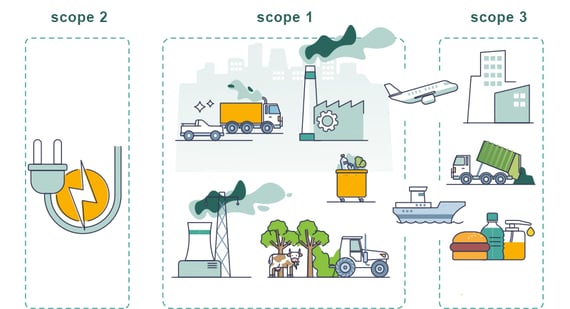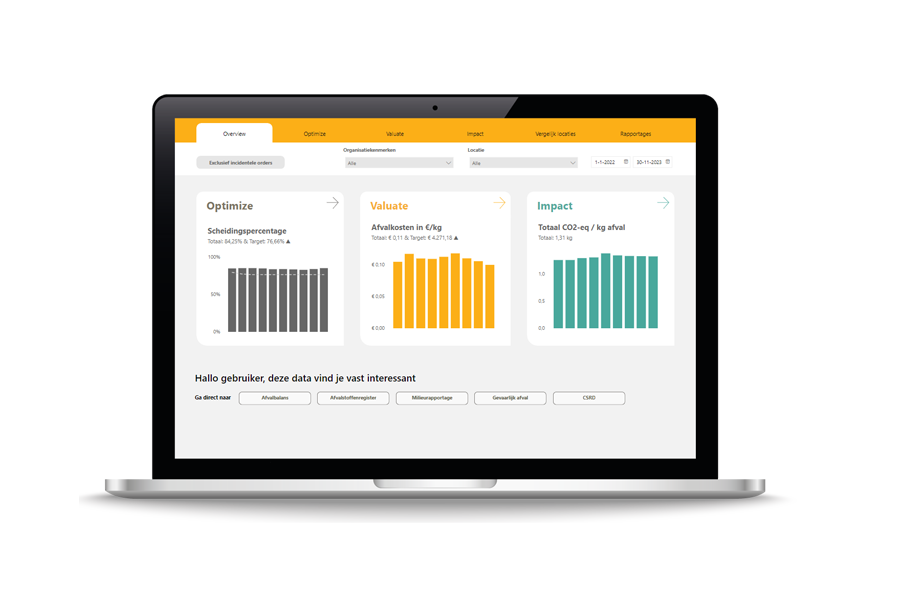Worldwide, companies, governments and nonprofit organizations apply the Greenhouse Gas Protocol as the guiding framework for measuring and managing greenhouse gas emissions. This reporting is critical to achieving global climate goals. Did you know that waste plays an important role in this? In this article you ontdet how. You will also read how Milgro helps you understand emissions from waste management. Even when this data seems far beyond your reach.
What is the Greenhouse Gas protocol?
The Greenhouse Gas protocol (GHG) is an internationally recognized framework for measuring and managing greenhouse gas emissions. This is measured in CO2eq. The protocol provides a standardized methodology and guidelines for collecting, calculating and reporting emissions. It allows organizations to accurately measure their climate impacts and develop strategies to reduce them.
One of the key features of the GHG Protocol is the categorization of emissions into three different scopes. Emissions are categorized based on the degree of control an organization has over the sources of emissions. Emissions under a company's direct control fall within scope 1. Scope 2 refers to a company's direct capital control. Indirect emissions over which a company has little control because they are part of the external value-chain fall within scope 3.
What is CO2eq?In addition to carbon dioxide (CO2), greenhouse gases such as methane (CH4), nitrogen (NOx) and water vapor also contribute to the greenhouse effect. To compare the impact of different types of greenhouse gases, emissions are expressed and measured in CO2 equivalents (CO2eq). In this process, the greenhouse effect is based on the equivalent of 1 kilogram of CO2. For example, one ton of methane is equivalent to 25 tons of CO2eq. This means that the contribution of methane to the greenhouse effect is 25 times that of carbon dioxide.
Scope 1: directe emission
Scope 1 of the GHG Protocol includes your company's direct CO2eq emissions. These are emissions from sources owned or controlled by your company. The emissions are directly caused by facility-, transportation- or production-related activities of your company, such as:
- Gas consumption within a company
- Fuel from transportation
- Machines in a plant that produce emissions during the production process
Scope 2: indirect emissions
Your company's indirect CO2 emissions fall within scope 2. These are emissions of energy that do not belong within your own company, but are purchased by you. The production of CO2 emissions is beyond the control of your own company. Consider emissions released from the generation of purchased energy, such as:
- Electricity
- Heat
- Cooling
As much as 40% of global GHG emissions belong to scope 2. This makes it the largest source of GHG emissions worldwide.
Scope 3: other indirect emissions
Within scope 3, the focus is not only on what happens within a company, but the entire life cycle of a product. This means that a chain analysis is needed to understand a production process from beginning to end. From the collection of raw materials to the moment a product reaches the consumer.
Within scope 3, 15 categories have been defined that cover the entire life cycle of a product. These categories are divided into upstream and downstream supply chain activities.
Read also

Fact sheet updated CO2 reporting
Upstream supply chain
Upstream supply chain activities include all the processes that take place around your company's purchase or acquisition of goods and services. We illustrate scope 3 indirect emissions with the example of a cookie factory:
- The CO2 emissions from machinery required to extract the raw materials, which are used to produce the plastic cookie packaging.
- The CO2 emissions generated from transporting plastic to the factory, from which the cookie packaging is made.
- The CO2 emissions resulting from commuting by the factory's employees.
- The CO2 emissions resulting from business travel, for example to trade fairs.
Downstream supply chain
Downstream supply chain activities occur after the product leaves your company. Thus, indirect greenhouse gas emissions occur when the product is no longer owned by your organization. With that, you also have no control over these emissions. In the example of our cookie factory, that's about it:
- The CO2 emissions produced in processing the waste generated after consumption of the cookies.
- The CO2 emissions produced when disposing of, for example, unusable plastic, cardboard boxes or wasted cookies.
- The CO2 emissions produced when the manufacturer makes investments, which are unrelated to its own business.
Read also

CO2 emissions and waste streams
Reporting on greenhouse gas emissions
The Greenhouse Gas Protocol requires you as a company to report and account for all emissions that fall within scope 1 and scope 2. This means you must measure and manage the direct emissions your company produces (scope 1) and the indirect emissions from purchased energy (scope 2). Reporting on scope 3 is currently optional. Nevertheless, this could also become mandatory in the future.
The emissions within scope 1 and scope 2 of your company may very well be the scope 3 emissions of another company. Only when every company reports the GHG emissions within all three scopes can we as a society truly control our emissions. This is precisely why a clear understanding of all three scopes of the GHG Protocol is crucial.
Waste management and the scopes
Measuring and managing waste streams enables you as a company to reduce your overall carbon emissions. With waste management as part of your reporting, you can take effective measures to reduce waste. In this way, you meet the requirements of the GHG Protocol while realizing a positive impact on the environment.
For processors and receivers of waste, the waste treatment process is in scope 1. This includes activities such as landfilling waste, incineration (including incineration for energy generation), receiving for recycling, composting and wastewater treatment. Waste management companies have direct control over these activities, including the fuel of the transport trucks that receive the waste and the machinery that processes the waste.
For many manufacturing companies, however, waste processing falls within scope 3. This is because they themselves have no direct control over the processing of their waste streams. Because of this, you may think it is impossible to gain insight into greenhouse gas emissions within scope 3. And that's where Milgro comes in.
Here's how to measure waste in scope 3
Is waste in scope 3 for your company, so you cannot directly influence the greenhouse gas emissions associated with it? Using the following methods, you can still gain insight into the CO2eq of your company's waste.
- Request scope 1 and 2 data directly from the recipients and/or processors of your waste.
- Calculate the emissions based on the type of waste and the method of waste processing. To do this, you will need sufficient insight into your company's various waste streams. You will also need to collect the emission factors that apply to each type of waste.
- Take the average of published data on your method of waste treatment. To do this, you will need to collect several pieces of data: the total mass of waste (in tons), the proportion of waste methods and the emissions that these processing methods emit. Quite a lot of arithmetic, in other words. With also an uncertain result, because it concerns averages per waste treatment method.
Getting started
Does your company want to get a head start on CO2 reduction and sustainability? Then discover how Milgro's dashboard offers you insight into scope 3 emissions. Even when waste management seems like a complex puzzle. The Milgro dashboard offers clear insight into waste streams and the CO2eq of your waste. Do not wait until it is too late. With perhaps mandatory scope 3 reporting in the future, now is the time to get ahead.
Stay informed
Stay up to date on all new developments? Follow us on LinkedIn or Instagram. Or subscribe to the newsletter. Are you curious about what Milgro can do for your operations and waste process? Contact us









